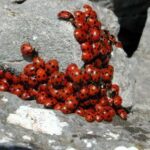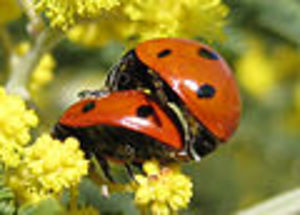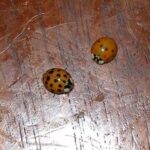Ladybugs, also known as ladybirds and lady beetles, have been popular through the United States since the 1800s when they were imported from Australia in an attempt to save orange trees. It worked, and as a result, there are several hundred species of ladybugs thriving in North America.
Gardeners love ladybugs because they feed on soft-bodies insects, such as aphids, green flies, mealy bugs, as well as other crop pests. In a single day, a ladybug is capable of eating over 1,000 aphids.
Ladybugs emerge from hibernation in the spring and will remain active until late fall. If you are having trouble with garden pests and want more ladybugs, you can precede two ways. You can try to attract ladybugs to your garden or you can purchase them and release them into your garden. Both methods are discussed below.
Attracting Ladybugs
Like any living creature, ladybugs will be attracted naturally to areas where they can find food, shelter, and water. If your garden is overrun with pests, you may feel that you have the food part covered. However, this is not always the case. Aphids can also attract ants, which collect honeydew from the aphids. These ants will often attack and drive off ladybugs and other predators. Therefore, you may need to control the ants before you are capable of attracting ladybugs.
Adult ladybugs also need pollen and nectar. Ladybugs are attracted to umbrella shaped flowers such as fennel, dill, cilantro, angelica, tansy, and caraway. Coriander, alyssum, cosmos, coreopsis, geraniums, and weeds such as dandelions, yarrow, and wild carrot are also attractive to ladybugs. However, you might also want to offer artificial food sources, such as sugar water or a mixture of sugar, water, and yeast. Providing other water sources, like a birdbath, will also help attract ladybugs.
You will want to avoid using pesticides. Not only will they kill the ladybugs, but it will also eliminate their food source making your garden unattractive to them. If you must use an insecticide, consider using one that is safe for ladybugs such as bacillus thuringiensis, pyrethrum, neem, and some other horticultural oils and soaps.
Often times, gardeners mistake ladybug larvae for pests, so be careful what you kill. Ladybugs breed and lay eggs throughout the summer, so larvae can be present at anytime. Educate yourself on what ladybug larvae looks like in order to prevent this problem.
Ladybugs also need shelter to lay eggs and eventually hibernate. Ladybug houses, also known as ladybug habitation boxes, are a great way to lure ladybugs to your garden. Fill the box with dry leaves and mount it on a tree or pole about three to five feet. The box should be protected from the wind while still receiving sunlight.
Artificial pheromone-based ladybug lures are also available at most garden centers. Place a few drops of this liquid on the inside of your ladybug house or mix it with water and spray it on unpainted objects in your garden.
Purchasing Ladybugs
Before purchasing ladybugs, you should take several of the steps listed above to make your garden more attractive to them. Otherwise, you will find your purchased ladybugs flying off to inhabit your neighbors’ gardens.
Do not purchase ladybugs that have been raised indoors. For some reason, they are unable to find their own food when they are released. Also, avoid purchasing a species of Asian ladybugs, Harmonia axyridis. They have the nasty habit of entering dwellings in large numbers when the weather gets cold. Thankfully, the USDA has outlawed them for this very reason, but there may be a few suppliers who are unaware-or uncaring-about this issue.
If the weather is warm, place the ladybugs in the fridge overnight before you release them. It will prevent them from flying off the minute they are released. You should also release them after sundown or before sun-up because ladybugs use the sun to navigate-they will stay put when it is dark. It is also helpful if you water the area where you intend to release the ladybugs.
Finally, if you have any severely infested plants, consider draping a thin sheet over the plant and releasing the ladybugs underneath. The sheet will give the ladybugs time to find the aphids and can be removed a day or two later.
Expect most of the ladybugs you release to fly away. Ladybugs are capable of migrating long distances and generally do not stay where they are introduced. To add to the problem, ladybugs tend to go into a reproductive diapause for several weeks after they are collected, which means they will not produce or lay any eggs.
With a little work, your garden will soon be a ladybug paradise and an aphid’s worst nightmare.
Sources:
http://www.seedsofknowledge.com/ladybugs.html
http://www.gardenandhearth.com/GardenCooking/Attracting-Ladybugs.htm





